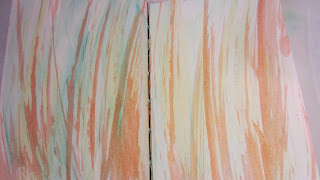 |
| Background is a collage of blues glued with acrylic medium. |
1.
Choose a hardback book with thick/sturdy pages;
the content might relate to the theme of your journal and you then integrate
the words/pictures with your work OR it might have nothing to do with the
journal and the pages and cover are entirely covered so there is no sense of
the original text/book.
2.
Cover the journal cover—first or last; your
choice. Cover the inside front and back covers to hide the material used to
cover the exterior.
3.
Tear out pages—leave 15-20 pages throughout the
entire book.
4.
Generic background preparation—experiment with
techniques and use various media and colors to partially cover half to
two-thirds of the pages; leave the rest to do later as you learn new ideas.
a. Black
gesso—leaving a few key words/phrases exposed
b. White
gesso— leaving a few key words/phrases exposed
c. Watercolors
and/or covering a page with large background stamps
d. Acrylics
e. Pastels
f.
Pencils
g. Translucent
papers/napkins
5.
Choose a theological theme/reflection
6.
Integrate with a specific art technique
a. Image
transfer prayer labyrinth on a page that has been covered with watercolors—use
as prayers of the people past/present/future
b. Soap
on black gesso with colored pencils—Bible verse/story; listening to God
c. Subtract
text
d. Doodle
edge
e. Rubber
stamping combined with watercolors and theological words
f.
Stacked journaling (wax resist)—heart wounds or
sermon/teaching prep
g. Collage—pretty
papers; magazine clippings/words; stamped words; stacked journaling
I added mini pictures of previously completed altered book pages and then selectively hand colored some of the images with colored pencils.
 |
| The completed page. |
 |
| An oceanside view for artsy theology: Los Cabos, Mexico. |






















































